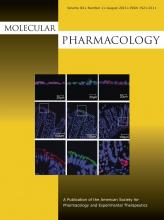Abstract
The D1 dopamine receptor (D1R) has been proposed to form a hetero-oligomer with the D2 dopamine receptor (D2R), which in turn results in a complex that couples to phospholipase C–mediated intracellular calcium release. We have sought to elucidate the pharmacology and mechanism of action of this putative signaling pathway. Dopamine dose-response curves assaying intracellular calcium mobilization in cells heterologously expressing the D1 and D2 subtypes, either alone or in combination, and using subtype selective ligands revealed that concurrent stimulation is required for coupling. Surprisingly, characterization of a putative D1-D2 heteromer-selective ligand, 6-chloro-2,3,4,5-tetrahydro-3-methyl-1-(3-methylphenyl)-1H-3-benzazepine-7,8-diol (SKF83959), found no stimulation of calcium release, but it did find a broad range of cross-reactivity with other G protein–coupled receptors. In contrast, SKF83959 appeared to be an antagonist of calcium mobilization. Overexpression of Gqα with the D1 and D2 dopamine receptors enhanced the dopamine-stimulated calcium response. However, this was also observed in cells expressing Gqα with only the D1R. Inactivation of Gi or Gs with pertussis or cholera toxin, respectively, largely, but not entirely, reduced the calcium response in D1R and D2R cotransfected cells. Moreover, sequestration of Gβγ subunits through overexpression of G protein receptor kinase 2 mutants either completely or largely eliminated dopamine-stimulated calcium mobilization. Our data suggest that the mechanism of D1R/D2R–mediated calcium signaling involves more than receptor-mediated Gq protein activation, may largely involve downstream signaling pathways, and may not be completely heteromer-specific. In addition, SKF83959 may not exhibit selective activation of D1-D2 heteromers, and its significant cross-reactivity to other receptors warrants careful interpretation of its use in vivo.
Footnotes
- Received January 24, 2013.
- Accepted May 16, 2013.
This work was supported in part by the Intramural Research Program of the National Institutes of Health [National Institute of Neurological Disorders and Stroke]; and the National Institutes of Health National Institute of Mental Health Psychoactive Drug Screening Program.
↵
 This article has supplemental material available at molpharm.aspetjournals.org.
This article has supplemental material available at molpharm.aspetjournals.org.
- U.S. Government work not protected by U.S. copyright
MolPharm articles become freely available 12 months after publication, and remain freely available for 5 years.Non-open access articles that fall outside this five year window are available only to institutional subscribers and current ASPET members, or through the article purchase feature at the bottom of the page.
|







